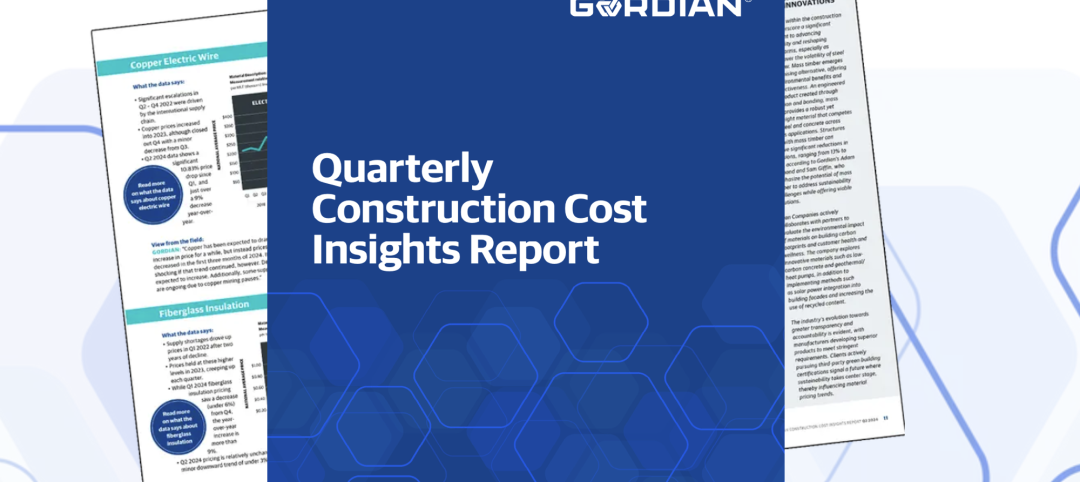Imagine a future in which you could access building information modeling technology anywhere, at any time. A future in which you could tap unlimited computing resources with the click of a mouse and crack even the most complex building analysis task with virtually no delay.
Imagine a future in which collaboration would be painless, integration seamless, and access to architecture, engineering, and construction expertise limitless. Finally, imagine a future where the ability to plug-and-play business partners into your project teams could be done with almost no effort.
At first, this might sound too good to be true. But just as BIM has significantly enhanced how Building Teams plan, deliver, and manage the built environment, cloud computing is now set to revolutionize BIM. According to “Sizing the Cloud,” an April 2011 research paper by Stefan Reid (published by Forrester Research), the global market for cloud computing will reach $241 billion in 2020. Clearly, cloud computing is poised to challenge traditional business models and create substantial opportunities globally for AEC firms.
Defining the cloud
The traditional approach to computing involves buying hardware—laptops, servers, routers, modems, switches, and so on—and software, then bringing in support personnel and project managers to tackle everything from integrating BIM systems to upgrading procurement tools, all under the direction of a chief information officer.
In contrast, cloud computing delivers computing as a service rather than as a physical product. Essentially, it enables AEC firms to rent computing infrastructure, software, and systems through the Internet on an as-needed basis, thereby liberating design and construction firms from much of the traditional cost and bother of IT infrastructure.
Such a setup has several unique properties that give cloud computing the capability to transform the nonresidential design and construction sector:
• Ubiquitous access — The ability to access project information and software functionality on any device, from any connected location, at any time.
• Infinite computing — The cloud is infinitely scalable, at least in terms of computing firepower that can be directed at your processing requirements. This means the traditional bottlenecks created by how much capability you can pack into a single desktop PC are now sidestepped, unleashing a whole new era of supercomputing.
• Evergreen service marketplace — The cloud is a democratic environment, enabling anyone to package up knowledge as a service and become a service provider. The recent explosion in smart phone apps is just one example. Now imagine the power of accessing the most current knowledge from across the AEC sector’s constituency.
BIM and the cloud
So, what happens when BIM processes enter the cloud? First, some of the traditional challenges that AEC firms encounter when implementing BIM are neatly sidestepped. Frequently, this occurs as a result of model collaboration, as well as the well-known limitations of desktop computing power to handle data-heavy models. “BIM enables a virtual design and construction process,” says Jonathan Mallie, principal and managing director at New York City-based SHoP Construction (www.shop-construction.com), an industry leader in integrating emerging technologies. “We see the use of cloud computing as a way to better use BIM in the VDC process.”
Second, and more significantly, BIM in the cloud helps reshape the competitive landscape across AEC, enabling any company in the supply chain to offer BIM-based services. Consider the following:
• Information collaboration — With a model located in the cloud supporting concurrent, controlled access and manipulation of all project information, the overhead associated with exchanging models and managing information integrity across the project constituency evaporates. There is one model, one version.
As project integrator, SHoP Construction is currently implementing a Web-based BIM management tool on the B2 Modular Housing Project in the Atlantic Yards in Brooklyn, N.Y. “We envision the model becoming a visual database of searchable project information, much like an Internet search engine,” says Mallie. “The Internet wouldn’t be very useful if it only had one person on it. The more stakeholders contributing to the model, the more valuable that model becomes.”
• Business collaboration — Accessing complete information through cloud-based services while more easily and effectively collaborating with new business partners on your project offers the potential to significantly improve the traditional relationship between Building Team member firms. Conversely, there’s the possibility to be a provider of that knowledge via one or more BIM services. Got a process for determining total cost of ownership for energy use or carbon analysis? Offer it as a BIM service.
Working on the Barclays Center Arena in Brooklyn, SHoP prototyped a Web-based portal to enable project stakeholders to track the fabrication and installation progress of no less than 12,000 uniquely sized steel panels for the arena’s façade. “The constantly updated 4D model evolved into a critical tool for the design-build team to understand where we were in production and how schedule changes would impact installation,” says Mallie. “What was initiated for internal use developed into a teamwide collaborative process.”
• Iteration — As BIM’s capability moves beyond the spatial processes of physical coordination into realms of the open-ended analytical, the need to undertake concurrent, exhaustive analysis across multiple dimensions (energy, carbon, whole-life cost, maintainability, etc.) continues to grow. Crunching vast amounts of data isn’t feasible in a desktop environment. Accessing the cloud’s infinite computing capabilities, however, enables Building Teams to optimize design across all constraints.
• Scalability — With the varying workload profile in the AEC environment, it can be tricky to get the size and mix of your so-called “IT estate” just right. Though a certain minimum level is always needed, the on-demand rental nature of the cloud helps you better flex along with your workload. A significant section of your hardware, software, and even support components can be more rationally aligned with your workload.
Opening new windows of opportunity
As BIM enters the cloud, the process is primed to provide efficiency and productivity benefits across the asset life cycle; it will significantly accelerate the manner in which the AEC sector plans, builds, and manages the built environment. BIM will also give rise to a range of new opportunities for AEC sector businesses to become service providers.
Five years ago, “clash detection” was a largely unknown term, while BIM was still the stuff of theory. “In the early phase of BIM, the challenge was to generate the information,” says SHoP’s Mallie. “Now, we have a great deal of data, and the true challenge is to manage and use that data most effectively. The cloud is an important tool in helping us do just that.”
Make no mistake: The AEC industry is on the cusp of a still more significant evolution with cloud computing. +
--
Dominic Thasarathar is a Senior Industry Program Manager for Construction at Autodesk, Inc.
Related Stories
Mass Timber | May 31, 2024
Mass timber a big part of Western Washington University’s net-zero ambitions
Western Washington University, in Bellingham, Wash., 90 miles from Seattle, is in the process of expanding its ABET-accredited programs for electrical engineering, computer engineering and science, and energy science. As part of that process, the university is building Kaiser Borsari Hall, the 54,000-sf new home for those academic disciplines that will include teaching labs, research labs, classrooms, collaborative spaces, and administrative offices.
Construction Costs | May 31, 2024
Despite challenges, 2024 construction material prices continue to stabilize
Gordian’s Q2 2024 Quarterly Construction Cost Insights Report indicates that supply chain issues notwithstanding, many commodities are exhibiting price normalization.
University Buildings | May 30, 2024
Washington University School of Medicine opens one of the world’s largest neuroscience research buildings
In St. Louis’ Cortex Innovation District, Washington University School of Medicine recently opened its new Jeffrey T. Fort Neuroscience Research Building. Designed by CannonDesign and Perkins&Will, the 11-story, 609,000-sf facility is one of the largest neuroscience buildings in the world.
Architects | May 30, 2024
AE firm Goodwyn Mills Cawood merges with Southland Engineering
Architecture and engineering firm Goodwyn Mills Cawood (GMC) is further expanding its services through a strategic merger with engineering firm Southland Engineering in Cartersville, Ga.
K-12 Schools | May 30, 2024
Inclusive design strategies to transform learning spaces
Students with disabilities and those experiencing mental health and behavioral conditions represent a group of the most vulnerable students at risk for failing to connect educationally and socially. Educators and school districts are struggling to accommodate all of these nuanced and, at times, overlapping conditions.
MFPRO+ New Projects | May 29, 2024
Two San Francisco multifamily high rises install onsite water recycling systems
Two high-rise apartment buildings in San Francisco have installed onsite water recycling systems that will reuse a total of 3.9 million gallons of wastewater annually. The recycled water will be used for toilet flushing, cooling towers, and landscape irrigation to significantly reduce water usage in both buildings.
Healthcare Facilities | May 28, 2024
Healthcare design: How to improve the parking experience for patients and families
Parking is likely a patient’s—and their families—first and last touch with a healthcare facility. As such, the arrival and departure parking experience can have a profound impact on their experience with the healthcare facility, writes Beth Bryan, PE, PTOE, PTP, STP2, Principal, Project Manager, Walter P Moore.
Urban Planning | May 28, 2024
‘Flowing’ design emphasizes interaction at Bellevue, Wash., development
The three-tower 1,030,000-sf office and retail development designed by Graphite Design Group in collaboration with Compton Design Office for Vulcan Real Estate is attracting some of the world’s largest names in tech and hospitality.
MFPRO+ News | May 28, 2024
ENERGY STAR NextGen Certification for New Homes and Apartments launched
The U.S. Environmental Protection Agency recently launched ENERGY STAR NextGen Certified Homes and Apartments, a voluntary certification program for new residential buildings. The program will increase national energy and emissions savings by accelerating the building industry’s adoption of advanced, energy-efficient technologies, according to an EPA news release.
Women in Design+Construction | May 28, 2024
Commerce Department launches Million Women in Construction Community Pledge
The U.S. Department of Commerce launched its Million Women in Construction Community Pledge this month to boost the ranks of women in construction companies. Federal investments are creating a construction boom that is increasing job opportunities for construction and trade workers.

















